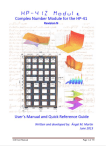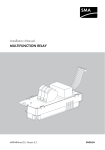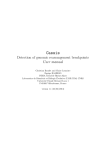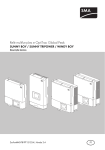Download User Manual
Transcript
User Manual HaploMerger2 Release 20151031, built Oct 31, 2015 Manual version: v3.1 Author and maintainer: Shengfeng Huang ([email protected]) 1 Table of contents Liability and disclaimer .................................................................................................................. 3 Introduction ..................................................................................................................................... 3 Limitations ....................................................................................................................................... 3 Citations ........................................................................................................................................... 4 Installation ....................................................................................................................................... 6 Understanding the HaploMerger2 pipeline .................................................................................. 7 Quick Start – testing HM2 with the example 1 and 2 .................................................................. 9 Start your own project .................................................................................................................. 11 Details of Operations – a walk-through with the example 3 ..................................................... 12 Step 0: preparation................................................................................................................ 12 Step 1: run hm.batchA1-3 to remove major misjoins from the diploid assembly ........... 13 Step 2: run hm.batchB1-5 to create the haploid assemblies .............................................. 15 Step 3: run hm.batchC1-2 to further scaffold the haploid assemblies.............................. 17 Step 4: run hm.batchD1-3 to remove tandem errors from the haploid assembliy .......... 18 Step 5: run hm.batchE1 to try to fill some gaps in the haploid assembliy ....................... 19 Advanced Topics............................................................................................................................ 20 1. How to soft-mask the raw diploid genome assembly? ................................................... 20 2. How to speed up HaploMerger2? .................................................................................... 20 3. How to increase alignment specificity? ........................................................................... 20 4. How to increase alignment sensitivity? ........................................................................... 21 5. How to remove allele redundancy as much as possible?................................................ 21 6. How to avoid removing non-redundant sequences?....................................................... 22 7. How to avoid falsely connecting two scaffolds? .............................................................. 22 8. Can I use HaploMerger on polymorphic mulit-ploid assemblies?................................ 22 9. Can I use HaploMerger on meta-genomic assemblies? ................................................. 22 Other Tools .................................................................................................................................... 23 1. lastz_D_Wrapper.pl .......................................................................................................... 23 2. count_scf_ctg ..................................................................................................................... 23 3. countN50_from_agp.pl ..................................................................................................... 23 2 Liability and disclaimer HaploMerger2 is free for academic use. This software comes without any warranty. Users should use it at their own risk and we cannot guarantee that this software will fulfill any of your particular purposes or needs. Introduction HaploMerger2 is an automated pipeline designed and assembled to facilitate the analysis of a highly polymorphic diploid genome assembly. It can be used to: 1. re-construct the allelic relationships within a diploid assembly; 2. detect and correct mis-joins in a diploid assembly; 3. reconstruct two haploid assemblies for the diploid assembly: the reference haploid assembly containing the primary alleles, and the alternative haploid assembly collecting all other alleles not included in the reference assembly; 4. further scaffold a haploid assembly (by using third-party software) to restore or even achieve better continuity; 5. detect and remove tandem mis-assemblies from haploid assemblies; 6. finish N-gaps in haploid assemblies (by using third-party software) to achieve better contiguity. Limitations HaploMerger2 is not a de novo genome assembler or scaffolder, and is not an annotation pipeline. HaploMerger2 only works for polymorphic diploid genome assemblies. HaploMerger2 is not suitable to work on the assemblies with a scaffold N50 size <50Kb; it barely works when the scaffold N50>50Kb; it works better when the scaffold N50>100Kb; and it works much better when scaffold N50>150Kb. The raw diploid genome assembly should be pre-soft-masked by using winMasker or repeatMasker; otherwise the program may be kept running for months. Currently, HaploMerger2 only provides compiled Lastz and chainNet executables for CentOS 5/6 (redhat 5/6) and ubuntu10-64bit. For other systems or environments, you may need to recompile these executables by yourself. 3 Citations An real application of HaploMerger Huang, S., Chen, Z., Yan, X., Yu, T., Huang, G., Yan, Q., Pontarotti, P.A., Zhao, H., Li, J., Yang, P., et al. Decelerated genome evolution in modern vertebrates revealed by analysis of multiple lancelet genomes. Nat Commun 5, 5896. (2014) The original paper to describe the algorithms of HaploMerger Huang, S., Chen, Z., Huang, G., Yu, T., Yang, P., Li, J., Fu, Y., Yuan, S., Chen, S., and Xu, A. HaploMerger: reconstructing allelic relationships for polymorphic diploid genome assemblies. Genome Res 22, 1581‐1588. (2012) 4 Requirements Multi-threading Perl version 5.10.1 or above. [Required] You may run the command “perl –v” to check if your Perl executable has multi-threading support enabled: “This is perl, v5.XX.X (*) built for x86_64-linux-gnu-thread-multi”. LASTZ. [Required; a copy is already shipped with the HaploMerger2 package] This is a local sequence alignment program used to generate highly-sensitive all-against-all genome alignments. Website: http://www.bx.psu.edu/~rsharris/lastz/ Citation: Harris RS. 2007. Improved pairwise alignment of genomic DNA. PhD Thesis, The Pennsylvania State University. And also: Schwartz S, et al. 2003. Human‐mouse alignments with BLASTZ. Genome Res 13(1): 103‐107. ChainNet programs. [Required; a copy is already shipped with the HaploMerger2 package] They are used to compute the reciprocally-best pairwise genome alignments. Website: http://hgdownload.cse.ucsc.edu/admin/jksrc.zip Citation: Kent WJ, et al. 2003. Evolution's cauldron: duplication, deletion, and rearrangement in the mouse and human genomes. Proc Natl Acad Sci U S A 100(20): 11484‐11489. WinMasker. [Optional; recommended] This program does a very good job in soft-masking a draft genome sequence. Website: http://www.ncbi.nlm.nih.gov/IEB/ToolBox/CPP_DOC/lxr/source/src/app/winmasker/ Citation: Morgulis A, et al. 2006. WindowMasker: window‐based masker for sequenced genomes. Bioinformatics. 15;22(2):134‐41. SSPACE standard v3.0. [Optional; recommended] This perl script is a fast, robust hierarchical scaffolder for genome assemblies. Website: http://www.baseclear.com/genomics/bioinformatics/basetools/SSPACE Citation: Boetzer M, et al. 2010. Scaffolding pre‐assembled contigs using SSPACE. Bioinformatics. 27(4):578‐579. GapCloser v1.12. [Optional; recommended] This program is dedicated to fill the N-gaps emerged during the scaffolding process. Website: http://sourceforge.net/projects/soapdenovo2/files/GapCloser/bin/ Citation: Luo R, et al. 2012. SOAPdenovo2: an empirically improved memory‐efficient short‐read de novo assembler. GigaScience. 1(1):18. Gmaj. [Optional] This is an alignment viewer for the MAF-formatted alignments output by HaploMerger2. Website: http://globin.bx.psu.edu/dist/gmaj/ Description of the MAF format: http://genome.ucsc.edu/FAQ/FAQformat.html#format5 5 Installation HaploMerger2 (HM2) has been tested on CentOS/RedHat v5/6 and Ubuntu v10.04-64bit. Download the latest standalone HaploMerger2 package from our website (http://mosas.sysu.edu.cn/genome/download_softwares.php) and unpack it to any directory you like. You will see a directory tree like this: >HaploMerger2_20151031 >>bin ## all perl and C programs of HM2 >>lastz_1.02.00_centOS5 >>lastz_1.02.00_centOS6 >>lastz_1.02.00_unbuntu64bit >>chainNet_jksrc20100603_centOS5 >>chainNet_jksrc20100603_centOS6 >>chainNet_jksrc20100603_unbuntu64bit >>winMasker >>gapCloser_v1.12 >>SSPACE-STANDARD-3.0_linux-x86_64 >>project_template ## shell scripts and parameter files >>project_example1 >>project_example2 >>project_example3 Directories chainNet* and lastz* contain the pre-compiled executables for chainNet and Lastz. Select the right version according to your linux system and add these directories to your own $PATH so that HM2 scripts can access them. If these executables do not work in your linux system, you may download the source code and recompile them by yourself. Directories winMasker, gapCloser_v1.12 and SSPACE-STANDARD-3.0_linux-x86_64 are empty. If you want to benefit from these software packages, you should download and compile them by yourself and put them to these directories (see the “Requirements” section). Please add these directories to your own $PATH so that HM2 scripts can access them. If you want a real application example for HM2, please 1) download the raw diploid assembly of Chinese lancelet from our website and put it under directory project_example3, 2) download two short-gun libraries (accession: SRX1364942 and SRX1364943) as well as 2/3/5/8/20kb mate-pair libraries (accessions: SRX1421071, SRX1421072, SRX1421073 and SRX1421074) from the NCBI SRA database, and place them under directory project_example3/libraries. Please read the README.txt/doc in directory project_example3 for more information. 6 Understanding the HaploMerger2 pipeline Enter the directory named project_template and list its files, you will see: >run_all.batch ## the master shell script of all the following shell scripts >hm.batchA1.initiation_and_all_lastz ## run all-against-all whole genome alignment >hm.batchA2.chainNet_and_netToMaf ## compute reciprocally-best alignment >hm.batchA3.misjoin_processing ## misjoin detection and removal >hm.batchB1.initiation_and_all_lastz >hm.batchB2.chainNet_and_netToMaf >hm.batchB3.haplomerger ## create initial haploid assemblies >hm.batchB4.refine_unpaired_sequences ## refine unpaired sequences (single alleles) >hm.batchB5.merge_paired_and_unpaired_sequences## create final haploid assemblies >hm.batchC1.hierarchical_scaffolding ## further scaffold the haploid assembly >hm.batchC2.update_reference_and_alternative_assemblies ## output new assemblies >hm.batchD1.initiation_and_all_lastz >hm.batchD2.chainNet_and_netToMaf >hm.batchD3.remove_tandem_assemblies ## removal tandems from haploid assemblies >hm.batchE1.wrapper_for_gapCloser_v1.12 ## close N-gaps in haploid assemblies >scoreMatrix.q ## template: score matrix for lastz >scoreMatrix.default.q >scoreMatrix.stringent.q >scoreMatrix.more_stringent.q >all_lastz.ctl ## template: configuration for lastz >all_lastz.default.ctl >all_lastz.fast.ctl >libraries/ ## to hold reads libraries for scaffolding and gap filling >> gapCloser.cfg ## template: configuration for gapCloser >> sspace_libraries.list ## template: library list and configuration for SSPACE HM2 programs have been organized into several shell scripts (hm.batchA-E) which are supposed to be run in order, but certainly some of them can be skipped. Open and read the master shell script (run_all.batch) to get an idea on how to run these scripts. The master shell script is meant to be frequently modified by users to fulfill their particular purposes. The all_lastz.ctl file contains parameters which control the behavior of LASTZ. This file has been optimized for diploid genome assemblies with 4-5% heterozygosity and a medium haploid genome size (i.e., 500Mb). The scoreMatrix.q file contains a scoring scheme for alignments, which is optimized for the alignments (with 90-100% identity) of the lancelet diploid genome assemblies. Open and read each shell scripts. All scripts consist of three major parts:1) setting variables, which is meant to be frequently modified by users, 2) printing out the names of important output files, and 3) invocating executables. 7 8 Quick Start – testing HM2 with the example 1 and 2 Enter the directory named project_example1/2. There are two files and one directory in it, including README.txt/doc, genome.fa.gz and test1/2_correct_output. The genome.fa.gz file contains the example diploid genome sequences. Now, let us test if the core part of HM2 works correctly on your system (test1). 1. Copy hm.batchB1-5, all_lastz.ctl and scoreMatrix.q from project_template to project_example1. 2. Switch to the directory project_example1, and make sure that you set $PATH correctly so that all HM2 executables can be accessed. 3. Use genome.fa.gz as the input file (no need to type the suffix “fa.gz”) and run the following shell scripts step by step while observing the information on the monitor screen: $ ./hm.batchB1.initiation_and_all_lastz genome $ ./hm.batchB2.chainNet_and_netToMaf genome $ ./hm.batchB3.haplomerger genome $ ./hm.batchB4.refine_unpaired_sequences genome $ ./hm.batchB5.merge_paired_and_unpaired_sequences genome 4. Each script will finished in seconds and you will see each script outputs certain directories, files and logs in the current directory. After hm.batchB5 is done, you are supposed to get two final result files named ./genome_ref.fa.gz and ./genome_alt.fa.gz with four scaffold sequences in each of them. You may also compare your outputs with those in test1_correct_output for trouble shooting. Then, let us test a little more (test2). 1. Copy run_all.batch, hm.batchA/B/D*, all_lastz.ctl and scoreMatrix.q from project_template to project_example2. 2. Switch to the directory project_example2, and make sure that you set $PATH correctly so that all HM2 executables can be accessed. 3. This time, we use the master shell script to do the test. Open, modify and save run_all.batch: (a) set the $PATH correctly in line 6; (b) by adding a “#” to the beginning of the corresponding command lines, you should comment out all other shell scripts except hm.batchA/B/D*; (c) replace “your_assembly_name” with “genome” in line 20-22; replace “your_assembly_name_mp” with “genome_mp” in line 31-35; replace “your_assembly_name_mp_ref” with “genome_mp_ref” in line 53-55. 4. Return to the terminal and run: $ ./run_all.batch >run_all.log 2>&1 # # collect all screen output to run_all.log You can also run each script of hm.batchA/B/D* step by step to see how it is working. 5. Each script will finished in seconds and you will see each script outputs certain directories, files and logs in the current directory. You are supposed to get these final results: from hm.batchA1-3 ./genome_mp.fa.gz ## the diploid assembly with misjoins removed from hm.batchB1-5 ./genome_mp_ref.fa.gz ## the reference haploid assembly 9 ./genome_mp_alt.fa.gz ## the alternative haploid assembly from hm.batchD1-3 ./genome_mp_ref_rt.fa.gz ## the reference assembly with tandems removed 6. You may compare you outputs with those in test2_correct_output for trouble shooting. 10 Start your own project The minimum requirement for your own project is a diploid genome assembly in fasta format and is contained in a gzip-compressed file with suffix “.fa.gz”. This assembly must be soft-masked, which means that the repetitive sequences and low-complexity sequences should be represented in lowercases. Both RepeatMasker and winMasker can be used to soft-mask the diploid assembly. We recommend winMasker because it is sufficient for HM2, and is easier and faster to run without requiring prior knowledge of the repetitive sequences (which is usually not present for a newly-assembled genome). Please see “advance topic” for more information about softmasking. You may not want to mess up the project_template directory. So you build a new project directory called myProject in the HM2 directory and copy all files from project_template to your project directory. If you want to run hierarchical scaffolding and gap filling, please also put the reads libraries under myProject/libraries. Symbol links and gzipped fasta files are accepted. NOTE THAT run_all.batch, the “setting variable” section of all shell scripts and all configuration files (all_lastz.ctl, scoreMatrix.q, libraries/sspace_libraries.list and libraries/gapCloser.cfg) are meant to be modified by users to suit their particular preferences and purposes. For example, to speed up the process by allowing multiple threads, you may open the shell scripts and modify the following variable (if it is presented and configurable): threads=1 # the number of cpu cores to use (default=1). NOTE THAT you are supposed to run all shell scripts and commands in your project directory! NOTE THAT if you have more than several thousand scaffolds, you need to increase the openable file handle number by invocate “ulimit –n 655350”. You may need the root privilege to do so. The shell scripts will print the names of the major output files to the monitor. The most important output files are those fasta-formatted genome assembly file placed in your project directory. These gzipped fasta files can the final resulted files, and can be used as input files for the next step or next round of HM2 procedures. Different suffixes will be added to the resulted assembly file names in order to discriminate between different steps of HM2 procedures: “_mp” added by hm.batchA stands for “misjoin_processing”; “_ref/alt” added by hm.batchB stands for “reference/alternative”; “_ss” added by hm.batchC stands for “secondary scaffolding”; “_rt” added by hm.batchD stands for “removing_tandems”; “_gf” added by hm.batchE stands for “gap_filling”. 11 Details of Operations – a walk-through with the example 3 Step 0: preparation Enter the directory named project_example3 and check around. The environment has been nearly set up. You need to down the bbv16wm.fa.gz file from our HaploMerger2 downloading website and place it in project_example3. This fasta file contains the soft-masked (by winMasker) diploid genome assembly of a wild-type Chinese lancelet. We are going to run HM2 on this genome assembly. If you want to test the hierarchical scaffolding and the N-gap filling functions, please down the short-gun and paired-end reads libraries (in Fastq format) from the NCBI SRA database and place them in the directory project_example3/libraries. Accession SRX1364942: Please separate read#0 and read#1 into two gzipped Fastq file named 5_1/2.cor.fq.gz. Accession SRX1364943: Please separate read#0 and read#1 into two gzipped Fastq file named 7_1/2.cor.fq.gz. Accession SRX1421071: Store reads of run 2kb_libraries_pair1 as a gzipped Fastq file named pe2kb40bp.1.fq.gz. Store reads of run 2kb_libraries_pair2 as a gzipped Fastq file named pe2kb40bp.2.fq.gz. Note that SSPACE does not care about the read name; only the read order matters. Accession SRX1421072: Store reads of run 3kb_libraries_pair1 as a gzipped Fastq file named pe3kb40bp.1.fq.gz. Store reads of run 3kb_libraries_pair2 as a gzipped Fastq file named pe3kb40bp.2.fq.gz. Note that SSPACE does not care about the read name; only the read order matters. Accession SRX1421073: Store reads of run 8kb_libraries_pair1 as a gzipped Fastq file named pe8kb40bp.1.fq.gz. Store reads of run 8kb_libraries_pair2 as a gzipped Fastq file named pe8kb40bp.2.fq.gz. Note that SSPACE does not care about the read name; only the read order matters. Accession SRX1421071: Store reads of run 20kb_libraries_pair1 as a gzipped Fastq file named pe20kb40bp.1.fq.gz. Store reads of run 20kb_libraries_pair2 as a gzipped Fastq file named pe20kb40bp.2.fq.gz. Note that SSPACE does not care about the read name; only the read order matters. HM2 have been organized into several shell scripts named as hm.batchA-E. They serve as both script files and parameter files. To set parameters you should open them with a text editor to modify the parameters. The following figure shows the content of hm.batchA1. 12 Finally, open and read run_all.batch to understand the whole process. Edit the $PATH variable to suit your environment. You may want to examine the result after each step, you may comment out the steps your do not want to run currently. Step 1: run hm.batchA1-3 to remove major misjoins from the diploid assembly hm.batchA1.initiation_and_all_lastz bbv16wm. It creates a set of required files, and then invocates LASTZ to produce raw all-against-all whole-genome alignments for your diploid genome sequences. Alignment files are stored in the directory bbv16wm.bbv16wmx.result/raw.axt. Raw alignments occupy a lot of disk space; you can delete it once you have successfully finished the next script. hm.batchA2.chainNet_and_netToMaf bbv16wm. It uses the ChainNet algorithm to create reciprocally-best single-coverage pairwise whole-genome alignments. Both hm.batchA1 and 2 can be parallelized to speed up the alignment process. Open both script files and set the thread number that you want to use: threads=1 # the number of cpu cores to use (default=1). Make sure you have that number of spare CPU/core to allocate. Each thread requires 1Gb memory at the default setting, and that a total of 4-8Gb memory should be available for dynamic allocation (required by the chainNet process). To reduce non-orthologous alignments, edit hm.batchA1 and set a proper identity threshold: identity=80 # output only lastz alignments >= $identity (default=80). Identity of 80% works fine in many situations, but you may increase it for more stringent filtering. Empirically, if allelic difference of your genome is 4-5%, you may set it to 88-92% to achieve a more stringent filtering. You are recommended to use a more flexible method to discriminate between allelic and non-allelic alignments by using a genome-specific scoreMatrix.q. There are two important parameter files (all_lastz.ctl and scoreMatrix.q) which are used to control the behavior of alignment process. The file all_lastz.ctl controls the behavior of LASTZ program. For example, you may set “--step=1” to “--step=20” to speed up the LASTZ process by >200%. Theoretically, “--step=20” may cause the loss of alignment sensitivity. Note that the parameters in this file may greatly affect running time, memory consumption, and alignment 13 sensitivity/specificity. The default setting in this file is a good starting point for your project, but you may modify any of these parameters to meet your needs. For detailed usage of these parameters, you may refer to the LASTZ manual. The file scoreMatrix.q contains a nucleotide substitution score matrix which is used by both LASTZ and chainNet. The default matrix is inferred from the Chinese lancelet diploid genome assembly and is a good starting point for your project. However, because difference diploid genomes have different heterozygosity rates and GC bias, so it is highly recommended to infer a score matrix specific for your own genome assembly to achieve optimal alignment sensitivity and specificity! Theoretically, a more stringent scoring scheme can both increasing alignment specificity and saving running time, but in the cost of losing alignment sensitivity. LASTZ provide a program (lastz_D) to infer the score matrix for a provided genome sequence. Please see “Advanced topics” and “Other tools” to learn how to infer score matrix. And see the LASTZ manual for more information. hm.batchA3.misjoin_processing bbv16wm. It invocates three Perl programs to do five tasks: 1. to pre-filter the reciprocally-best whole-geome chainNet alignments and make them perfectly-mirrored; 2. to convert whole-genome alignment into a directed graph (the DGA graph); 3. to traverse the DGA graph using a greedy algorithm and search for misjoins; 4. to break the two involved scaffolds at the misjoining point; 5. output the diploid assembly based on the processed DGA graph. A set of parameters control the behavior of this script. breakingMode, aliFilter, and overhangFilter. There are events in which the long-term co-linearity of two haplotypes is violated: . These events may represent assembly errors, or to a less probability, allele-specific chromosome rearrangements. HM2 breaks both scaffolds at the breaking point (breakingMode must be set to 2). The option aliFilter controls the minimum alignment score (the default is about 50kb), whereas the option overhangFilter controls the minimum length of the unaligned scaffold portions (the default is about 50kb). The higher of these two options are, the more reliable an event of co-linearity violation is found. scoreScheme=<score|ali>. HM2 ranks the alignments in certain order. A higher rank means an alignment is longer and is more reliable in representing a pair of allelic sequences. Alignments can be ranked by their score 14 or their alignment length (the length excluding small indel, gaps and Ns). Currently, you should choose to use the “score” scheme. filterScore_1, escapeFilter, filterScore_2 and NsLCsFilter. Most of the low-scored alignments are spurious and can be classify as “noise”. Three options are used to control the filtering of noise. Option filterScore_1 control the filtering on the graph creating stage; option filterScore_2 is the second round of filtering in the course of the DGA graph traversing; option escapeFilter allow to retain those low-scored alignments (<filterScore_2) if they cover XX% of the scaffold sequence length. Note that there is no exact demarcation between noise and non-noise alignments, but the default setting should serve as a suitable starting point. Empirically, to meet the criterion of filterScore_2=200000, an alignment should have at least 2000 perfect match nucleotides without gaps, indels and Ns. For some scaffold sequences short than, like, 2000bp, the setting filterScore_2=200000 makes no sense. In this case, option escapeFilter helps to reclaim the alignments involving short scaffold sequences. However, these short alignments still have to pass the criterion filterScore_1. Some alignments mainly comprise of Ns and repeats, option NsLCsFilter can help to remove these alignments. This option operates independently. In addition, there are several output files describing the co-linearity violation events: hm.scaffolds - information of original scaffolds hm.nodes - information of the alignment blocks (a block is a node) hm.portions - information of the partions of original scaffolds hm.new_scaffolds - the solved relations between two haplotypic scaffolds hm.assembly_errors - potential assembly errors in the original assembly **** About running multiple rounds of misjoin removing on the diploid assembly **** Because misjoins can affect the genome alignments, one round of hm.batchA1-3 may not identify all potential misjoins. You can use the output diploid assembly file as the input for a second round of hm.batchA1-3. Usually 2-3 rounds of hm.batchA1-3 will be sufficient. You can also lower aliFilter, and overhangFilter (from the default 50kb to 40kb, but caution against values lower than 30kb) to allow more misjoins to be processed in the second and the third rounds. Step 2: run hm.batchB1-5 to create the haploid assemblies hm.batchB1.initiation_and_all_lastz bbv16wm_mp. hm.batchB2.chainNet_and_netToMaf bbv16wm_mp. This two scripts are similar to those of the Step1, except that 1) the input diploid assembly file should be the output of the Step 1, and 2) and the pairwise chainNet alignments are output in MAF format. You may examine these MAF alignments with Gmaj or other alignment viewers. hm.batchB3.haplomerger bbv16wm_mp. This script invocates three Perl programs to do four tasks: 1. to pre-filter the reciprocally-best whole-geome alignments and make them perfectly-mirrored; 15 2. 3. 4. to convert whole-genome alignment into a directed graph (the DGA graph); to traverse and linearize the DGA graph using a greedy algorithm; to output the raw reference and alternative haploid assemblies based on the linearized DGA graph. The parameters of this script are similar to that of hm.batchA3. We note that increasing filterScore_2 and escapeFilter may reduce the chance of merging two sequences which are not really alleles. However, it will cause the resulted haploid assembly to lose some correct alignments and to include more redundant sequences (redundancy means that both alleles are included in the resulted assembly). Some alignments mainly comprise of Ns and repeats, option “NsLCsFilter” can help to remove these alignments (this option operates independently). HaploMerger is able to connect two scaffolds into one if they share an overlapping region (alignments). The option minOverlap controls the minimum alignment length (excluding Ns, gaps and indels) that can trigger a connecting operation. You can set minOverlap to zero (the default) to let HaploMerger to connect any connectable scaffolds. However, since all low-scored alignments will be filtered out by the option filterScore_2, so the minimum alignment length for scaffold connecting is actually large than filterScore_2. Increase minOverlap can make the retained connections more trustable in the cost of losing many possible connections. Because any connection will mix two haplotypes together, and in some cases you don’t want to mix up haplotypes or to generate switches between haplotypes. In these cases, you may set minOverlap to a very large value, such as 99,999,999. Three important output files will be generated and placed under the directory bbv16wm_mp.bbv16wm_mpx.result. optiNewScaffolds.fa.gz - contains new scaffolds with alignment supports optiNewScaffolds_alt.fa.gz - new alternative scaffolds with alignment supports unpaired.fa.gz - new scaffolds with no alignment supports The third file collects scaffolds that have no trustable alignments shared with other scaffolds. In addition, there are many other output files describing the DGA graph structure and the co-linearity violation events: hm.scaffolds - information of original scaffolds hm.nodes - information of the alignment blocks (a block is a node) hm.portions - information of the partions of original scaffolds hm.new_scaffolds - the solved relations between two haplotypic scaffolds hm.assembly_errors - potential assembly errors in the original assembly hm.unpaired - a list of the unpaired scaffolds hm.connections - the alignment blocks connecting two different scaffolds hm.unpaired_updated - an updated list of the unpaired scaffolds 16 These data can be used for further refinement, manual inspection and also for secondary exploitation. Note that all data files are output in TAB-separated format, and there is detailed explanatory description inside these files. You may open them with a text editor or Excel. hm.batchB4.refine_unpaired_sequences bbv16wm_mp. The unpaired.fa.gz file contains those scaffolds without alignment supports. Several reasons will cause this: 1) some sequences have no corresponding allelic sequences in the diploid assembly; 2) a pair of alleles/haplotypes is collapsed into one sequence; 3) some true alignments between alleles are relatively weak and filtered out in the Stage I & II; 4) some alignments mainly consist of Ns and repeats and hence have been filtered out; 5) some alignments are related to tandem duplication, inversion and translocation, and they don’t considered in the linearized DGA graph currently; 6) besides, in the course of graph traversing, some portions of scaffolds can be cut off (such as the free ends of a scaffold, which fail to be aligned), which also collect into the unpaired.fa.gz file. Considering the origin of these sequences, one may expect that a large proportion of these sequences may actually redundant. This script is developed to identify those redundant sequences and to remove them from the unpaired.fa.gz file. This script aligns the sequences in unpaired.fa.gz against to those in optiNewScaffolds.fa.gz; then it removed the potentially-redundant sequences from unpaired.fa.gz if they can be found (aligned) in optiNewScaffolds.fa.gz. It produces a new output Fasta file named unpaired_refined.fa.gz. You may use multiple CPU/cores by setting the “threads” option. You may set the “identity” option to control the sensitivity and specificity of the alignment. The value may set lower that that used in the Stage I to recover more alignments. You may set the “maskFilter” option to filter out those scaffolds mainly comprised of Ns and repeats. You may set the “redundantFilter” option to filter out those scaffolds having corresponding allelic sequences in the optiNewScaffolds.fa.gz file. hm.batchB5.merge_paired_and_unpaired_sequences bbv16wm_mp. It merges optiNewScaffolds.fa.gz and unpaired_refined.fa.gz to produce the reference haploid assembly (bbv18wm_mp_ref.fa.gz), and merges optiNewScaffolds_alt.fa.gz and unpaired_refined.fa.gz to produce the alternative haploid assembly (bbv18wm_mp_alt.fa.gz). When there are two alleles representing a genomic locus, they will be separately placed in bbv18wm_mp_ref.fa.gz and bbv18wm_mp_alt.fa.gz. When there is only one representing allele for a genomic locus, this allele will be placed in both the reference and the alternative assemblies. Step 3: run hm.batchC1-2 to further scaffold the haploid assemblies hm.batchC1.hierarchical_scaffolding bbv16wm_mp_ref 17 This script invocates the SSPACE v3.0 to further scaffold the haploid assembly. We only need to feed the reference haploid assembly to scaffolding. There are several options for this script: threads=1 # the number of cpu cores to use (default=1) minimumLinks=5 # Minimum number of links (read pairs) to compute scaffold libraryList="libraries/sspace_libraries.list" # the libary list file for SSPACE The libraries/sspace_libraries.list file contains the mate-pair libraries. We note that short distance mate-pairs should be used before the long distance mate pair. For more information on the usage of SSPACE v3.0, please refer to its manual. hm.batchC2.update_reference_and_alternative_assemblies 16wm_mp_ref This script finalizes the scaffolding and outputs the new reference (bbv18wm_mp_ref_ss.fa.gz) and the new alternative (bbv18wm_mp_alt_ss.fa.gz) haploid assemblies. **** About running multiple rounds of hm.batchC1-2 on the haploid assembly **** After the first round of scaffolding, some new joining possibilities will emerge for the new assembly. You may use the output haploid assembly file as the input for a second round of hm.batchC1-2. Usually 2-3 rounds of hm.batchC1-2 will be sufficient. You may also lower minimumLinks to allow less reliable joining of scaffolds in a second round of scaffolding. Step 4: run hm.batchD1-3 to remove tandem errors from the haploid assembliy Normally, only the reference haploid assembly needs to be processed, but if you want to process the alternative haploid assembly, you may feed the alternative assembly file to hm.batchD1-3. Previous studies showed that genome assemblies with high polymorphism (such as Ciona savignyi and Branchiostoma floridae) contain many tandem assembly errors, which means two alleles are mistakenly assembled in tandem. This kind of errors affects up to 12% of the genome sequence (or 6% of the allelic sequences). hm.batchD1.initiation_and_all_lastz bbv18wm_mp_ref_ss hm.batchD2.chainNet_and_netToMaf bbv18wm_mp_ref_ss These two scripts do things similar to hm.batchA1-2 and hm.batchB1-2. hm.batchD3.remove_tandem_assemblies 18wm_mp_ref_ss This script detects and cuts away the tandem mis-assembled region and rejoins the sequence. The script utilizes a novel algorithm to automatically detect and remove these tandem assembly errors from the haploid assembly with high precision. There are two options to control the size of tandems for processing: filterAli and minLen. minLen controls the minimum alignment length for consideration of removing, while filterAli directly filters out alignments whose length lower than the given value. Normally, both options could be set to the same value. HM2 can detect and removal potential tandem errors with size as small as 200bp. For the two tandem assembled alleles, HaploMerger chooses to remove the shorter ones 18 with more Ns. **** About running multiple rounds of hm.batchD1-3 on the haploid assembly **** Different sizes of tandem mis-assemblies can interfere with each other, therefore multiple rounds of tandem removal may be needed. You can use the output haploid assembly file as the input for a second round of hm.batchD1-3. We recommend to remove tandems from large sizes to small sizes, for example: round1: filterAli=4000 and minLen=5000 round2: filterAli=2400 and minLen=3000 round3: filterAli=1000 and minLen=1500 Step 5: run hm.batchE1 to try to fill some gaps in the haploid assembliy Normally, only the reference haploid assembly needs to be processed, but if you want to process the alternative haploid assembly, you may feed the alternative assembly file to hm.batchE1. hm.batchE1.wrapper_for_gapCloser_v1.12 bbv18wm_mp_ref_ss_rt It invocates the gapCloser v1.12 to try to fill the N-gaps in the reference haploid assembly. GapCloser tries to tile reads into the gaps, but some gaps can be closed but the others cannot. This script retains those closed gaps because they are supposed to be more reliable. There are two options meant to be modified by users: threads=1 # the number of cpu cores to use (default=1) configFile="libraries/gapCloser.cfg" # the configFile for GapCloser v1.12; this parameter is transferred directly to the '-b' option of GapCloser v1.12 There are two output files: bbv18wm_mp_ref_ss_rt_gf.fa.gz # the haploid assembly with some gap filled; The contigs used to filled in the gaps are soft masked (in lower cases). bbv18wm_mp_ref_ss_rt_gf.agp # the AGP file showing the contig-scaffold structure of the assembly; The contigs used to filled in the gaps are labeled with a prefix “GF_” in the agp file. 19 Advanced Topics 1. How to soft-mask the raw diploid genome assembly? You can use RepeatMasker to soft-mask the raw diploid genome assembly, but that would require priori information about the repeat content of the genome, which is often not available for a newly-created genome assembly. Therefore, we recommend using WinMasker. You can run WinMasker on your genome assembly in two separate stages. # stage 1: create the reusable masking library ../winMasker/windowmasker_20120730 \ -checkdup true \ -mk_counts \ -in bbv16.fa \ # the Fasta formatted genome assembly -out masking_library.ustat \ # the library used for future masking -mem 6500 # stage 2: use the masking library to soft-mask the genome assembly ../winMasker/windowmasker_20120730 \ -ustat masking_library.ustat \ -in bbv16.fa \ # the input genome assembly -out bbv16wm.fa \ # the softmasked genome assembly -outfmt fasta \ -dust true The masking_library.ustat can be reuse on other assembly from the same sequencing data. 2. How to speed up HaploMerger2? The best way is to allocate more CPUs to HaploMerger. To change -step in all_lastz.ctl from 1 to 20 can shorten the alignment time by >75%. Theoretically, large step value may cause the loss of alignment sensitivity. To use a more stringent score matrix and to lower the gap cost threshold -ydrop in all_lastz.ctl can also save lots of time, but these will cause the loss of true alignments. So, it is not recommended unless you know what you do. To change –identity from 80 to 90 for hm.batchA or HM_all_lastz_mThreads.pl can force LASTZ to output only alignments with identity >90% and hence save some time. Again, it causes the loss of useful alignments. So, it is not recommended unless you know what you do. 3. How to increase alignment specificity? You may need to use soft-masking instead of hard-masking. LASTZ can take advantage of soft-masking by extending alignment into the soft-masked regions, hence improving the score and length of the alignment. You are highly recommended to use a score matrix specific for your genome sequence. It is probably the best way to control the alignment specificity without losing much sensitivity. You may use LASTZ_D to infer such a score matrix. Supposed that you have a genome sequence with 20 5% heterozygosity, then as a starting point, you may extract those alignments with 90-100% to infer a score matrix. See the section “Other tools” for more details. To change –identity from 80 to 90 for hm.batchA or HM_all_lastz_mThreads.pl can force LASTZ to output alignments with identity >90%. This will increase specificity greatly. You very unlikely lose any true pair of alleles by increasing the identity threshold provided that you are not setting it too high (e.g., higher than the heterzygosity rate). In fact, it helps to remove spurious allele pairs (=increase the specificity). Usually, a pair of allele contains a set of high-identity alignment blocks (i.e., core alignments) and a set of low-identity alignment blocks. An allele pair is better defined by long-term co-linearity and a set of core alignments. The chaining scheme of HaploMerger (i.e., the chainNet algorithm) can recovered the allele pair by chaining up the core alignments, regardless the presence/non-presence of low-identity alignments. However, it should be noted that low-identity alignments for a pair of alleles are sometimes useful, for example, guiding N-gap filling, but if you are like me, don’t really care about N-gap filling, then you are recommended to increase the identity threshold! However, perhaps instead of using this rigid way, you may use a score matrix with a slightly high threshold, like using alignments with 92-100% to generate the score matrix. 4. How to increase alignment sensitivity? You may need to use soft-masking instead of hard-masking. LASTZ can take advantage of soft-masking by extending alignment into the soft-masked region, hence recover many useful alignments. You can modify the all_lastz.ctl file: increase the –ydrop threshold for gap penalty, set –step to 1, and allow –transition for seeding patterns. A drawback of these settings is that before you know how many alignments has been recovered, you have to see the greatly increased running time and space occupation for LASTZ. It is also difficult to predict the outcome of these changes. You may need to try several times to see the effects. You can also use a less stringent score matrix like inferred from alignments with 80-100% identity (not recommended though), or a low –identity threshold like 70%. Again, it is difficult to predict the outcome of these changes. You may have to try several times to see the effects. 5. How to remove allele redundancy as much as possible? HaploMerger2 has several designs to help remove true redundancy without making false calls. You are recommended to feed all sequence data to HaploMerger2. HaploMerger is not only able to handle large data set, but benefit from it! A complete sequence data set is always needed for determining allele redundancy correctly and efficiently. A whole-genome alignment scheme based on LASTZ-ChainNet is a key, which helps to accurately identify true allele pairs. You may read the advanced topic 2&3 about the balance between alignment sensitivity and specificity. The DGA graph-based structure is another key, which accommodates full homologous/allelic relationships and permits a natural optimizing algorithm to separate true allele pairs from homologous sequence pairs. Since this part has been optimized, normally you don’t need to change anything, but you can still lower -filterScore_2 and -scapeFilter in hm.batchB to allow removing more redundant sequences. However, lower these two parameters will increase the risk 21 of removing non-redundant sequences (false removal). HaploMeger uses a novel algorithm (hm.batchD) to detect tandem alleles. Three parameters –minLen, - maxInterval and – minCoverage in hm.batchD can be used to control the sensitivity and specificity of the detection. You are recommended to use this function. HaploMerger also uses a second round of whole-genome alignment to reclaim/refine the redundant sequences (hm.batchB4). Three parameters, -identity, maskFilter, and –redundantFilter will help you to control the sensitivity and specificity. You are recommended to use this function. 6. How to avoid removing non-redundant sequences? This topic is quite the opposite of the topic 4. HaploMerger2 has been designed to achieve a balance on the problem, but you can still tweak it to what you like. You may increase the alignment specificity to suppress false calls of redundancy. You may increase -filterScore_2 and -scapeFilter in hm.batchB to suppress false calls of redundancy, if you prefer high specificity than sensitivity. It is worth noting that if you use the above methods to prevent false calls, then there is a risk for some true redundant sequences eluding you. Fortunately, many, if not all, of these sequences go to the unpaired.fa.gz file. You may reclaim them by using hm.batchB4. This is actual a mechanism which HaploMerger2 uses to achieve a high sensitivity without losing specificity. Finally, you may adjust three parameters, -identity, maskFilter, and –redundantFilter in hm.batchB4 to decide how many sequence to be re-classified as “non-redundant”. 7. How to avoid falsely connecting two scaffolds? Two scaffolds can be connected based on their overlapping alignment in order to extend the continuity of sequence. However, the overlapping alignment may be spurious. How to handle this? First, you are recommended to feed the complete genome sequence data to HaploMerger2, which helps to fight against spurious alignments. You may adjust the alignment specificity for this purpose. You may increase -filterScore_2 and -scapeFilter in hm.batchB to prevent low-scored alignments used for connection, in the cost of missing some true redundant alleles. You may set the –minOverlap parameter in hm.batchB to force HaploMerger2 to break a connection when the alignment for connection does not meet the minimum required length. In fact, you can set this parameter to a very large value so that no scaffolds will be connected at all. 8. Can I use HaploMerger on polymorphic mulit-ploid assemblies? Not tested. 9. Can I use HaploMerger on meta-genomic assemblies? No. 22 Other Tools 1. lastz_D_Wrapper.pl The LASTZ package includes a program called lastz_D. This executable can be used to infer score matrix specific to a given genome sequence. I wrote this wrapper to facilitate the use of lastz_D in HaploMerger2. To infer the score matrix for a diploid genome assembly, you should first divide the genome sequence file into two parts, one contains 5~15% sequences in size, and the other contains the rest of the genome sequences. Empirically, you may select the longest scaffold sequences into the first part. Save these two parts in separate files, then run: lastz_D_Wrapper.pl --target=part1.fa.gz --query=part2.fa.gz --identity=90. Input fasta files can be gzip or non-gzip files. The “--identity” option tells lastz_D to use only the alignments whose identity is >=90% (excluding Ns, indels, and gaps) for inference. The higher the identity is, the more stringent the scoring matrix will be, you are recommended to try at least two stringency level: >=90% and >=95%. Empirically, if allelic difference of your genome is 4-5%, you may set it to 90% as a starting point; if difference is 3% or 1%, you may set it to 94% or 96% as a starting point. An output file called part1.part2.raw.time.xx_xx.q will be generated after minutes or hours. You may open this file and copy the score matrix into the scoreMatrix.q file in your project directory. Note that lastz_D may take a lot of time and cannot be parallelized. So if you have a very large genome, then you may just select 5% of sequences into the target part. The use of >10% genome sequence is not recommended, because the chance of finding no allele for a scaffold is high and hence the inference is less reliable. Lastz_D sometimes may be stuck somewhere and provide strange results. Besides, different sequences may produce different inference. So, you may select different sequences into the part1.fa.gz file and rerun the program again. After that, you can choose a suitable one from several score matrices for further use. For more information of lastz_D, please refer to the LASTZ’s manual. 2. count_scf_ctg This executable calculates the scaffolds’ and contigs’ N05-N95 numbers and length. Run the executable with option “--help” for detailed usage. If the executable does not work, enter the directory named “installDir/bin/count_scf_ctg.source” and run “make” to recompile the utility and copy it to the “installDir/bin” directory. 3. countN50_from_agp.pl This perl script calculates scaffolds’ and contigs’ N50 sizes based on the AGP file. It is much faster than count_scf_ctg. 23






























